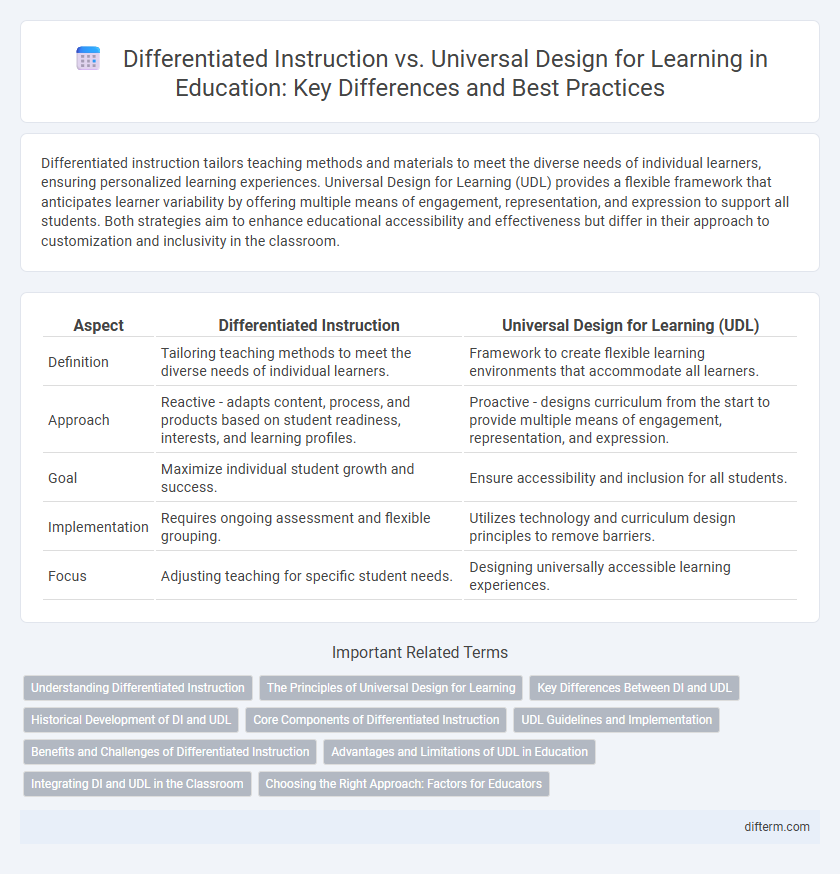Differentiated instruction tailors teaching methods and materials to meet the diverse needs of individual learners, ensuring personalized learning experiences. Universal Design for Learning (UDL) provides a flexible framework that anticipates learner variability by offering multiple means of engagement, representation, and expression to support all students. Both strategies aim to enhance educational accessibility and effectiveness but differ in their approach to customization and inclusivity in the classroom.
Table of Comparison
| Aspect | Differentiated Instruction | Universal Design for Learning (UDL) |
|---|---|---|
| Definition | Tailoring teaching methods to meet the diverse needs of individual learners. | Framework to create flexible learning environments that accommodate all learners. |
| Approach | Reactive - adapts content, process, and products based on student readiness, interests, and learning profiles. | Proactive - designs curriculum from the start to provide multiple means of engagement, representation, and expression. |
| Goal | Maximize individual student growth and success. | Ensure accessibility and inclusion for all students. |
| Implementation | Requires ongoing assessment and flexible grouping. | Utilizes technology and curriculum design principles to remove barriers. |
| Focus | Adjusting teaching for specific student needs. | Designing universally accessible learning experiences. |
Understanding Differentiated Instruction
Differentiated instruction tailors teaching methods and materials to meet the diverse learning needs, readiness levels, and interests of individual students within a classroom. It involves flexible grouping, varied assignments, and ongoing assessment to ensure all learners have access to the curriculum in ways best suited to their strengths. This student-centered approach contrasts with Universal Design for Learning, which proactively designs curriculum to be accessible to all learners from the outset.
The Principles of Universal Design for Learning
Universal Design for Learning (UDL) is grounded in three core principles: providing multiple means of engagement, representation, and action and expression, which collectively support diverse learners by accommodating various learning styles and abilities. Unlike differentiated instruction that tailors teaching to individual students, UDL proactively designs curricula to be flexible and accessible for all from the outset. This approach leverages neuroscientific research to create inclusive educational environments that enhance motivation, comprehension, and expression across heterogeneous classrooms.
Key Differences Between DI and UDL
Differentiated Instruction (DI) customizes teaching methods and materials to address individual student needs, preferences, and readiness levels, often requiring teachers to create multiple lesson plans or activities. Universal Design for Learning (UDL) offers a flexible, proactive framework that incorporates multiple means of engagement, representation, and expression to accommodate variability among all learners from the outset. While DI tends to adapt content on a case-by-case basis, UDL emphasizes designing inclusive curricula and environments that minimize barriers and maximize learning opportunities for diverse student populations.
Historical Development of DI and UDL
Differentiated Instruction (DI) emerged in the 1990s as educators sought strategies to tailor teaching to diverse student needs, emphasizing flexible content, process, and product modification. Universal Design for Learning (UDL) originated from architectural accessibility principles during the early 2000s, evolving into an educational framework that proactively designs curriculum to accommodate all learners through multiple means of engagement, representation, and expression. Both DI and UDL reflect a shift toward inclusive education, with DI focusing on responsive adaptation and UDL prioritizing proactive, barrier-free curriculum design.
Core Components of Differentiated Instruction
Differentiated instruction centers on tailoring content, process, and product based on students' readiness, interests, and learning profiles, ensuring individualized pathways to mastery. Core components include flexible grouping, ongoing assessment, and varied instructional strategies to meet diverse learner needs. Unlike Universal Design for Learning, which emphasizes proactive curriculum accessibility, differentiated instruction reacts dynamically to learner differences within the classroom.
UDL Guidelines and Implementation
Universal Design for Learning (UDL) Guidelines emphasize providing multiple means of engagement, representation, and expression to accommodate diverse learner needs and preferences. Implementing UDL involves proactive curriculum design that removes barriers by integrating flexible goals, materials, and assessments, ensuring accessibility and inclusivity for all students. Differentiated instruction customizes teaching based on individual student profiles, while UDL systematically embeds adaptability into curricula, promoting equitable learning opportunities across varied abilities and backgrounds.
Benefits and Challenges of Differentiated Instruction
Differentiated instruction enhances student engagement by tailoring teaching methods to diverse learning styles, strengths, and needs, fostering a more inclusive classroom environment. It allows educators to provide targeted support, promoting better academic outcomes and motivation among students with varying abilities and backgrounds. However, implementing differentiated instruction can be time-consuming and demands significant teacher expertise in assessment and curriculum adaptation to effectively manage diverse learner profiles.
Advantages and Limitations of UDL in Education
Universal Design for Learning (UDL) promotes inclusivity by providing flexible learning environments that accommodate diverse student needs, enhancing engagement and retention. Its advantages include fostering accessibility through multiple means of representation, expression, and engagement, benefiting all learners without the need for retrofitting. However, UDL's limitations lie in its implementation complexity, requiring substantial teacher training, resources, and time to design effective curricula that meet varied learning preferences.
Integrating DI and UDL in the Classroom
Integrating Differentiated Instruction (DI) and Universal Design for Learning (UDL) in the classroom enhances personalized learning by addressing diverse student needs through flexible teaching methods and adaptable learning environments. Combining DI's targeted strategies with UDL's proactive accessibility principles supports multiple means of engagement, representation, and expression, promoting equity and inclusivity for all learners. Effective integration fosters improved student motivation, comprehension, and academic achievement across varied abilities and learning styles.
Choosing the Right Approach: Factors for Educators
Educators must consider student diversity, including learning styles, abilities, and interests, when choosing between differentiated instruction and Universal Design for Learning (UDL). Differentiated instruction tailors teaching to individual needs through flexible content and assessment, whereas UDL emphasizes creating inclusive learning environments by providing multiple means of engagement, representation, and expression. Factors such as classroom size, available resources, and curriculum goals influence the effectiveness of each approach in promoting equitable student outcomes.
differentiated instruction vs universal design for learning Infographic

 difterm.com
difterm.com